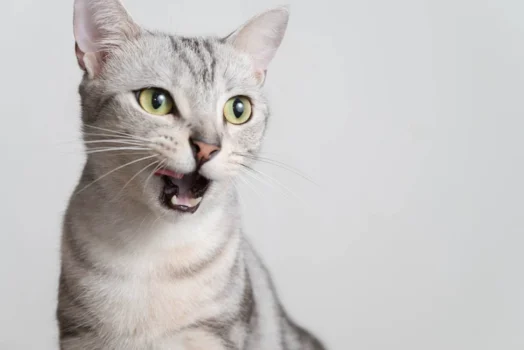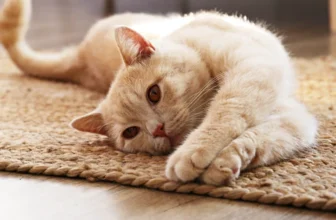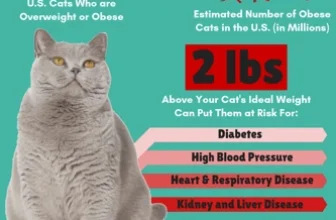Introduction
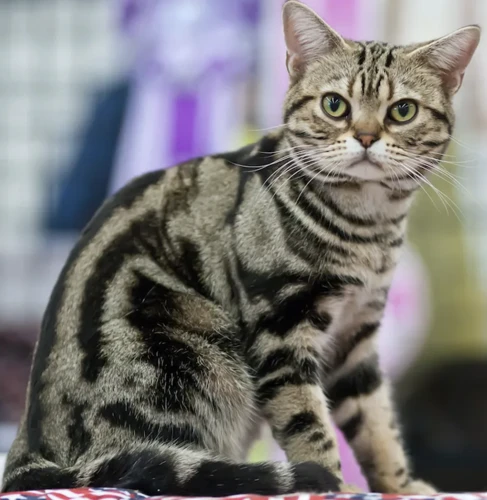
Welcoming a new addition to your family in the form of a fluffy and adorable American Shorthair can bring tremendous joy and comfort. However, with ownership comes significant responsibility, especially when it comes to your pet’s health. One of the most common health issues experienced by American Shorthairs is obesity. This problem can lead to numerous health problems and even impact their lifespan. In this article, we’ll provide you with a step-by-step guide on dealing with obesity-related health issues in American Shorthairs. Let’s get started and help your furry friend achieve the best possible health.
Understanding Obesity in American Shorthairs
Obesity is a common problem in cats, including American Shorthairs. It occurs when a cat consumes more calories than they burn through physical activities. In this condition, a cat’s body weight increases, which puts significant strain on their health. According to a 2018 survey by the Association for Pet Obesity Prevention, around 60% of cats in the United States are overweight or obese.
Body Condition Score is a crucial component in understanding obesity in American Shorthairs. Body Condition Score, or BCS, is a tool used to determine a cat’s body composition. It uses a scale of 1-9, where 1 signifies extremely emaciated and 9 is morbidly obese. BCS helps to assess a cat’s ideal weight, which depends on factors such as age, sex, and breed. In American Shorthairs, a healthy BCS is generally between 4-5.
Obesity increases the risk of numerous health issues, including diabetes, arthritis, heart disease, and hypertension, among others. Overweight American Shorthairs face difficulties in grooming themselves, which may lead to poor hygiene and skin issues. They also experience respiratory distress, and obesity may affect their quality of life by limiting their mobility. In some cases, obesity can cause premature death.
As an American Shorthair owner, it’s crucial to monitor their weight regularly and take action if you detect any signs of weight gain. In the next section, we will discuss some symptoms and risks of obesity that can help identify the condition in your furry friend.
If you want help with your American Shorthair losing weight, we highly recommend seeking professional help. You can find some helpful resources in our article on how to help your American Shorthair lose weight or learn more about the importance of portion control and weight management in American Shorthairs in our article on portion control for American Shorthairs.
Signs, Symptoms, and Risks of Obesity in AS
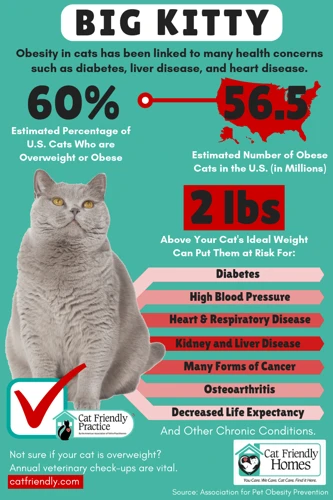
Obesity is a serious health concern that affects millions of American Shorthairs. Knowing the signs, symptoms, and risks associated with obesity is a crucial step towards keeping your furry companion healthy.
Signs of Obesity in American Shorthairs: Since every cat is unique, the signs of obesity can vary from one cat to another. However, some general signs might include a visibly protruding belly, difficulty in walking or running, shortness of breath or panting, and difficulty in grooming themselves, especially on their back. If you notice any of these symptoms, it is essential to speak with your vet as soon as possible.
Symptoms of Obesity in American Shorthairs: Obesity can lead to a wide range of symptoms and complications, including diabetes, arthritis, heart disease, and hypertension. Obese American Shorthairs are also at higher risk of developing urinary tract disease due to the pressure on their bladder from the excess weight.
Risks of Obesity in American Shorthairs: Obesity can shorten a cat’s lifespan and lead to a significantly reduced quality of life. Obese cats are also susceptible to various medical conditions from which they can suffer chronic pain. Obesity in American Shorthairs can lead to costly medical treatments, vet bills, and pet insurance premiums.
Recognizing the signs, symptoms, and risks of obesity in American Shorthairs is crucial to maintaining your pet’s health. By following proper dietary and exercise habits, regularly visiting the vet, and implementing the necessary medical treatments, you can help your American Shorthair avoid or overcome weight problems. By providing your cat with a healthy lifestyle, you can ensure a longer, happier life for your fluffy feline friend. For more information about indoor activities that can help to maintain your American Shorthair’s health, refer to our previous article on indoor activities for American Shorthair health.
Preventing Obesity in American Shorthairs
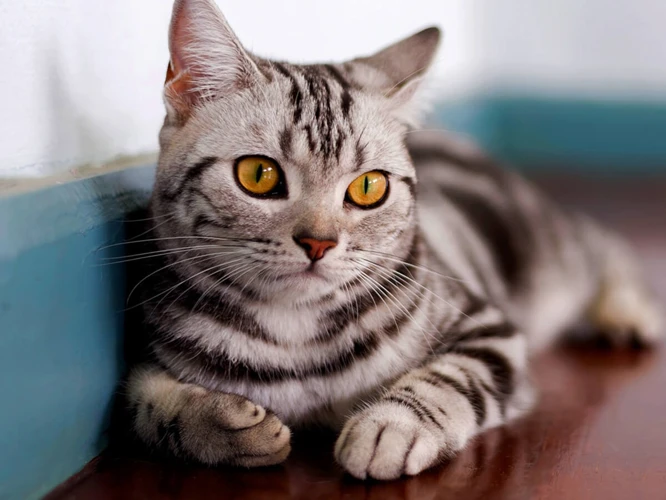
We all know that prevention is better than cure, and this is especially true when it comes to obesity in American Shorthairs. As pet owners, it is our responsibility to ensure that our furry friends maintain a healthy weight. By taking preventative measures, we can avoid the health risks associated with obesity and help our cats live a long and healthy life. In this section, we will discuss some preventive measures that you can take to help your American Shorthair maintain a healthy weight and avoid obesity-related health problems. Let’s take a look at some tips and techniques that can help you keep your American Shorthair happy and healthy.
Dietary Changes
Diet plays a crucial role in maintaining a healthy weight for American Shorthairs. Obese American Shorthairs tend to consume more calories than they burn, which leads to weight gain. Dietary changes such as portion control and feeding a balanced diet can help in preventing obesity.
One important dietary change that can help American Shorthairs lose weight is to limit their calorie intake. Cat owners can achieve this by feeding their cat smaller, more frequent meals rather than giving them all their food at once. It is also essential to feed them a balanced diet that meets all their nutritional needs.
According to a study, high-protein diets may be beneficial for weight loss in cats. A high-protein diet can help keep cats feeling full and satisfied longer, which can lead to a decrease in food intake. Moreover, low-calorie diets can also help cats lose weight by reducing their calorie intake.
Cat owners can choose to feed their American Shorthairs a combination of wet and dry foods. Wet foods are generally lower in calories and can help keep cats hydrated, while dry food can clean their teeth and satisfy their urge to chew.
It is essential to remember that abrupt changes to cats’ diets can lead to gastrointestinal problems, so it’s important to make dietary changes gradually. Also, feeding human food to American Shorthairs can put them at risk of obesity, so it’s essential to avoid giving them table scraps.
Along with dietary changes, regular physical exercise can help American Shorthairs maintain a healthy weight. Providing them with interactive toys and playtime can keep them physically active and mentally stimulated.
Also, understanding the Body Condition Score of American Shorthairs can help cat owners monitor their cat’s weight and make any necessary dietary changes.
Lastly, treating American Shorthairs with health treats can be an effective way of promoting weight loss. These treats are low in calories and can act as a healthy snack between meals.
Making dietary changes can be a crucial step in preventing and treating obesity in American Shorthairs. Feeding a balanced diet, controlling portions, and providing regular exercise can help maintain a healthy weight and prevent obesity-related health issues.
Physical Exercise
Keeping your American Shorthair (AS) active is an essential part of preventing obesity and managing weight-related health issues. Regular physical exercise can play a crucial role in burning off extra calories and helping your cat maintain a healthy weight.
Here are some effective physical exercises you can try with your AS:
| Exercise | How-To |
|---|---|
| Interactive Play | Interactive play, such as using toys such as feathers, laser pointers, or puzzle toys that stimulate hunting instincts, can be an excellent way to keep your AS engaged while also providing exercise. Take 10-15 minutes every day to play with your cat. |
| Obstacle Courses | Set up simple obstacle courses to encourage your AS to move around. Use boxes, tunnels, or even poles that they need to jump over to create fun and engaging activities. |
| Walking on a Leash | Believe it or not, some cats can learn to walk on a leash. This is a great way to take your AS outside and provide them with additional physical activity. |
| Climbing | Most cats are natural climbers. Providing your AS with adequate climbing options can be an excellent way to keep them active and healthy. You can provide climbing towers, wall shelves, or other structures for your furry friend to climb on. |
It is essential to keep in mind that like humans, cats have different levels of activity needs. Some may enjoy more rigorous physical exercise, while others prefer more gentle activities. You should try different activities and see what works best for your AS.
You should always start slow and gradually increase the intensity of physical exercises. Always consult with a veterinarian if you plan to make any significant changes to your cat’s exercise routine or diet.
Regular Vet Check-Ups
One of the most effective ways to prevent obesity in American Shorthairs is by scheduling regular vet check-ups. Veterinarians can provide crucial guidance on your cat’s health status and dietary habits. During a check-up, the vet will typically perform a physical examination to assess the cat’s overall health. They may also conduct blood and urine tests to check for any underlying medical conditions that may contribute to obesity.
In addition to checking your cat’s weight and body condition score, the vet will discuss their diet and exercise regimen with you. They can make recommendations based on your cat’s age, weight, and overall health. The vet can advise you on the appropriate portion sizes and the best type of food to give to your cat. They can also suggest ways to increase your cat’s physical activity, such as interactive toys or games that encourage movement.
Regular vet check-ups are also important for monitoring your cat’s progress in weight management. The vet can help you track your cat’s weight and body condition score over time, and adjust their diet and exercise plan as needed. By catching any weight gain early on, you can take action before it becomes a serious problem.
Scheduling regular vet check-ups is an important step in the prevention of obesity in American Shorthairs. It can help you identify any underlying health conditions and provide you with the guidance you need to maintain your cat’s health. By working collaboratively with your vet and following their recommendations, you can help keep your cat at a healthy weight and avoid the negative health consequences associated with obesity.
Some tips to make sure you schedule and attend regular vet check-ups:
- Set a reminder on your calendar or phone to schedule an appointment every six months
- Make sure to arrive at the vet’s office on time and prepared with any questions you may have
- Keep a record of your cat’s weight and body condition score between check-ups
- Communicate any changes to your cat’s diet or exercise routine with your vet
- Follow your vet’s recommendations for managing your cat’s weight and health
Treating Obesity in American Shorthairs
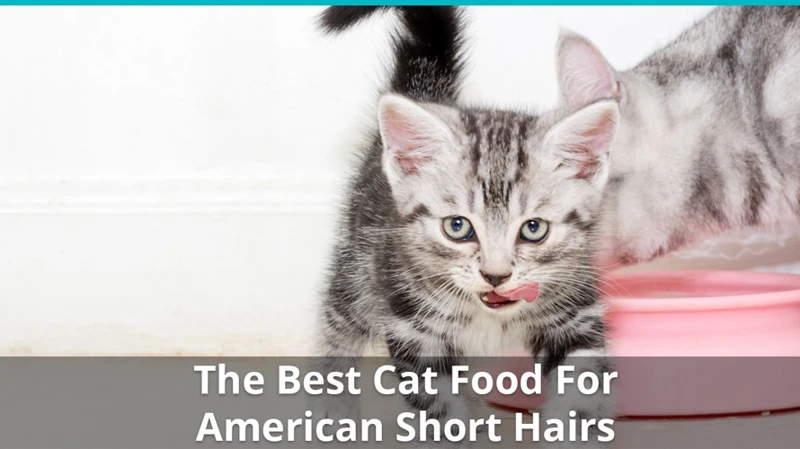
Dealing with obesity in American shorthairs is a challenging issue for pet owners. Despite the best efforts to prevent it, some American shorthairs may still become overweight or even obese. If your American shorthair is already obese, it’s important to take action to help them lose weight and improve their overall health. In this section, we will explore effective ways to help treat obesity in your American shorthair. These solutions range from dietary changes to physical exercise and even medical treatments, all of which can play a significant role in aiding in the weight loss journey of your feline friend. Let’s dive into the details below!
Dietary Changes
Proper nutrition is an important aspect of preventing and treating obesity in American Shorthairs (AS). Feeding your AS a nutritionally balanced and portion-controlled diet can help them maintain a healthy weight. Here are some tips for making dietary changes in your AS:
| Tip | Description |
|---|---|
| Measure and Monitor | Measuring your AS’s food and keeping track of the amount they eat can help you manage their calorie intake. Use a measuring cup or food scale to portion out your AS’s meals. Avoid free-feeding your AS, which means keeping their food bowl full all day, as it can lead to overeating. |
| Choose the Right Food | Choosing a high-quality cat food that is low in fat and calories can help your AS maintain a healthy weight. Look for cat food brands that are specifically formulated for weight management or consult with your veterinarian to determine a suitable diet for your AS. |
| Avoid Table Scraps | Avoid giving your AS table scraps as they can contribute to your AS’s weight gain and lead to nutrient imbalances. Human food can also be harmful to cats, as some ingredients, such as onions or garlic, can be toxic to them. |
| Limit Treats | Avoid giving your AS excessive treats, as they often contain high levels of calories and fat. Instead, use treats sparingly and opt for low-calorie options specifically formulated for cats. Always check with your veterinarian before making any changes to your AS’s diet. |
Incorporating these dietary changes can help prevent obesity in American Shorthairs and keep them healthy. Remember, it’s important to consult with your veterinarian before making any changes to your AS’s diet to ensure that their nutritional needs are being met.
Physical Exercise
One of the most effective ways to prevent and treat obesity in American Shorthairs is through regular physical exercise. Physical activity helps burn calories and increase metabolism, which in turn helps regulate weight.
It’s important to note that the amount of exercise your American Shorthair needs depends on their age, health, and overall activity level. Adult cats generally need at least 20-30 minutes of active playtime each day, but younger and more active cats may require even more.
When it comes to choosing the right exercise for your American Shorthair, consider their personality and preferences. Some cats enjoy chasing toys or strings, while others may prefer climbing or scratching posts. Set up a designated play area with plenty of toys and scratching surfaces to encourage your cat to stay active.
Here are some additional tips for incorporating physical exercise into your American Shorthair’s routine:
| Activity | Description |
|---|---|
| Interactive play | Use toys like lasers, wand toys, and crinkle balls to engage your cat in active play. Encourage running and jumping to get their heart rate up. |
| Scratching posts | Provide multiple scratching posts throughout your home to encourage your American Shorthair to stretch, climb, and stay active. |
| Climbing | Install wall shelves or cat trees to encourage your cat to climb and jump. This will help build muscle and improve their balance. |
| Outdoor time | If it’s safe and appropriate for your cat, take them outside for some fresh air and exploration. Just be sure to supervise them at all times. |
Regular physical exercise is key to preventing and treating obesity-related health issues in American Shorthairs. By incorporating playtime and activities into your cat’s routine, you can help them maintain a healthy weight and improve their overall wellbeing.
Medical Treatments
When preventing and treating obesity in American Shorthairs, sometimes dietary changes and physical exercise may not be enough. In some cases, medical treatments may be necessary as well. These treatments can include medication, surgery, or a combination of both.
Medication: There are several medications available that can help with weight loss in cats. One of the most common medications prescribed is called mirtazapine. However, before administering any medication, it is important to consult with a veterinarian. They will recommend the most appropriate medication based on the cat’s individual health needs and any pre-existing conditions.
Surgery: In extreme cases where diet and exercise alone do not lead to significant weight loss, surgery may be considered. This can include procedures such as gastric bypass or gastric banding. These procedures have proven to be effective in helping cats lose weight and maintain a healthy weight over time.
Combination Treatment: The most effective approach to treating obesity in American Shorthairs involves a combination of dietary changes, physical exercise, and medical treatments. In many cases, a veterinarian will recommend a combination of medication and a specific diet to help cats achieve their weight loss goals.
It is important to remember that medical treatments should always be used in conjunction with a healthy lifestyle. Even with medication or surgery, maintaining a healthy diet and exercise routine is essential in achieving long-term weight loss for American Shorthairs.
Managing Obesity-Related Health Issues
As obesity in American Shorthairs (AS) becomes more common, the risk of developing obesity-related health issues increases significantly. It’s important to understand that managing these health issues takes a well-rounded approach that includes a combination of dietary changes, physical exercise, and medical treatments. This can be overwhelming for pet owners, but taking a proactive approach and understanding the potential health risks is crucial in keeping your AS healthy and happy. Let’s explore some of the most common obesity-related health issues in AS and how to manage them.
Diabetes
One of the most significant health issues that can result from obesity in American Shorthairs is diabetes. When a cat is overweight, it puts extra strain on its pancreas which can result in a lack of insulin production. As a result, the cat’s blood sugar levels skyrocket, leading to diabetes.
Signs and Symptoms of Diabetes:
– Increased thirst and hunger
– Frequent urination
– Weight loss even though the cat is eating more
– Lethargy and weakness
– Vomiting
– Dehydration
Cats with diabetes require consistent care and management to keep their blood sugar levels stable. This typically involves insulin injections, careful monitoring of their diet, and regular exercise.
Managing Diabetes:
– Insulin Injections: Depending on the severity of the diabetes, cats may require one or two insulin injections per day. It’s crucial to follow instructions carefully and work with a veterinarian to ensure the correct dosage.
– Dietary Changes: In addition to careful insulin management, dietary changes can also help manage diabetes. Cats with diabetes may need to switch to a low-carbohydrate diet to help regulate their blood sugar levels.
– Regular Monitoring: Monitoring your cat’s blood sugar levels is a crucial part of managing diabetes. Regular check-ins with a veterinarian will help ensure that your cat is receiving the appropriate care.
Managing diabetes in an obese cat requires a great deal of dedication and effort. However, with the proper treatment and care, cats with diabetes can still lead happy and fulfilling lives.
Arthritis
Arthritis is a common health issue faced by American Shorthairs who are obese. The excess weight puts undue pressure on their joints, which leads to inflammation and pain. If your cat is suffering from arthritis, you may notice that they move stiffly, have difficulty jumping or climbing, or appear to be in pain.
One way to manage arthritis in American Shorthairs is to make changes to their diet and exercise routine. A diet that is rich in omega-3 fatty acids, such as those found in fish, can help to reduce inflammation and alleviate arthritis symptoms. Additionally, moderate exercise, such as playing with a toy or taking short walks, can help to strengthen your cat’s muscles and improve joint mobility.
In some cases, anti-inflammatory medications may be prescribed by your veterinarian to help manage your cat’s arthritis symptoms. These medications can help to reduce pain and inflammation, which can improve your cat’s quality of life. It is important to follow your vet’s instructions carefully when administering medication to your cat, as there may be potential side effects.
Another way to manage arthritis in American Shorthairs is to provide them with a comfortable living environment that will help to minimize pain and discomfort. For example, a soft bed or cushioned mat can help to reduce pressure on your cat’s joints, and ramps or steps can make it easier for them to climb onto furniture or navigate throughout your home.
Lastly, regular vet check-ups are crucial to manage arthritis in your American Shorthair. Your veterinarian can assess your cat’s arthritis symptoms and recommend the best course of action. By working together, you can help to manage your cat’s arthritis and provide them with a comfortable, pain-free life.
Heart Disease
As with diabetes and hypertension, heart disease is one of the most common health issues that can arise in American Shorthairs who have become obese. The extra weight puts a significant strain on the heart and cardiovascular system, which can lead to issues such as high blood pressure, atherosclerosis, and heart failure.
What are the signs of heart disease in American Shorthairs?
– Shortness of breath
– Lethargy
– Loss of appetite
– Difficulty breathing
– Lack of interest in physical activity
– Coughing
How can heart disease be treated?
Once heart disease is diagnosed, the first step to a successful treatment plan is usually a change in diet. Your veterinarian may recommend a low-sodium diet to help reduce hypertension and strain on the heart. Additionally, medications such as ACE inhibitors may be prescribed to help maintain blood pressure. It’s crucial to work closely with your vet to monitor your cat’s progress and make any necessary changes to the treatment plan.
How can heart disease be prevented?
Prevention is the best approach when it comes to heart disease. This can be achieved by helping your American Shorthair maintain a healthy weight through proper diet and exercise. Schedule regular check-ups with your veterinarian to monitor your cat’s weight and overall health. If your pet is already overweight or obese, work with your vet to develop a plan to help them lose weight in a safe and effective manner.
Conclusion
Heart disease is a serious condition that can greatly impact the health and lifespan of your American Shorthair. Understanding the signs of heart disease and taking steps to prevent and manage the condition can help your cat live a longer, healthier life. Focus on a healthy diet, regular exercise, and working closely with your veterinarian to ensure your pet is receiving proper care.
Hypertension
Hypertension, or high blood pressure, is a common health issue in obese American Shorthairs. When an AS cat is obese, their heart has to work harder to pump blood throughout the body, which in turn causes a rise in blood pressure. This can lead to serious health problems such as heart disease and kidney damage.
There are several ways to manage hypertension in American Shorthairs:
- Dietary Changes: Managing hypertension in AS cats starts with a proper diet. It is essential to limit the intake of sodium and increase the intake of potassium in their diet. Foods high in potassium, such as cooked spinach, salmon, and chicken, can help lower blood pressure. A low-sodium diet may also help to reduce hypertension in AS cats. Consult with a veterinarian to find the best diet plan for your cat.
- Medication: Some cats may require medication to manage hypertension. The type of medication and dosage will depend on the individual cat and their specific health needs. It is crucial to follow the vet’s instructions carefully when administering medications to avoid any potential adverse effects.
- Regular Vet Check-Ups: It is critical to take your AS cat for regular vet check-ups to monitor their blood pressure and overall health. This way, any changes or issues can be detected and managed early on, preventing further complications.
- Reducing Stress: Stress can contribute to an increase in blood pressure levels. It is essential to reduce stress factors in your cat’s environment. Providing a comfortable and soothing environment at home can help to keep your AS cat calm and relaxed, which in turn can reduce their blood pressure.
Managing hypertension in American Shorthairs requires a combination of dietary changes, medication, and regular vet check-ups. Reducing stress factors and creating a calm environment can also help manage hypertension levels in AS cats. It is crucial to work closely with a veterinarian to develop a customized treatment plan for your specific cat to ensure they lead a healthy and happy life.
Conclusion
After going through this article, it can be concluded that obesity is a severe issue among American Shorthairs and can lead to several health problems if left untreated. Understanding the signs, symptoms, and risks of obesity is crucial in preventing and treating obesity in American Shorthairs.
One of the primary ways to prevent obesity is by making necessary dietary changes and ensuring that your pet gets enough physical exercise. Regular vet checkups can also play a significant role in avoiding obesity-related health problems.
However, in some cases, even with proper preventive measures, American Shorthairs can become obese, and it is essential to understand how to treat it effectively. Dietary changes, physical exercise, and even medical treatments may be necessary to help your pet get back in shape.
Moreover, obesity can lead to several health issues such as diabetes, arthritis, heart disease, and hypertension. Managing these problems requires prompt identification and continuous monitoring, which can be challenging but crucial for a happy, healthy pet.
In conclusion, preventing and treating obesity and its related health problems in American Shorthairs requires proper attention, care, and a commitment to their well-being. By following the tips and ideas presented in this article, you can ensure that your pet lives a long, healthy life. Remember that a healthy pet is a happy pet.
Frequently Asked Questions
1. How do I know if my American Shorthair is obese?
Check for signs of a large, round belly, difficulty jumping or climbing, and excessive sleeping. You can also weigh your cat and compare it to their ideal weight for their age and breed.
2. Is obesity common in American Shorthairs?
Yes, obesity is a common problem in American Shorthairs due to their love of food and tendency towards being sedentary.
3. Can obesity lead to other health problems in American Shorthairs?
Yes, obesity can lead to diabetes, arthritis, heart disease, and hypertension in American Shorthairs.
4. What should I feed my American Shorthair to prevent obesity?
Feed your cat a balanced diet of high-quality protein, low-fat foods, and avoid overfeeding treats and table scraps. Consult with your vet to develop a specific diet plan for your cat.
5. How much exercise does my American Shorthair need to prevent obesity?
Experts recommend at least 20-30 minutes of playtime or physical activity per day for American Shorthairs to prevent obesity.
6. How can I encourage my American Shorthair to exercise?
Provide your cat with interactive toys, scratching posts, and place food and water bowls in different areas of the house to make them move around more. Consider scheduled playtime or training activities.
7. Can medications help with weight loss in American Shorthairs?
Yes, some medications can aid in weight loss, but should only be used under the supervision of a veterinarian.
8. What are the signs of diabetes in an American Shorthair?
Signs of diabetes in American Shorthairs include excessive thirst, urination, hunger, weight loss, and lethargy.
9. How can I help prevent arthritis in my American Shorthair?
Prevent arthritis in American Shorthairs by maintaining a healthy weight, providing regular exercise, and using joint supplements as recommended by your veterinarian.
10. Can heart disease be reversed in obese American Shorthairs?
Heart disease cannot be completely reversed, but weight loss and a healthy diet can help improve the condition in obese American Shorthairs.

